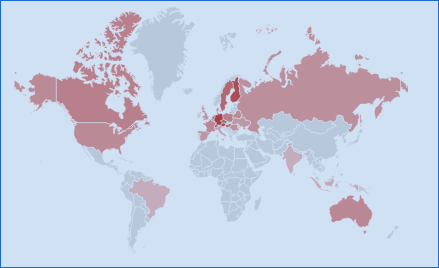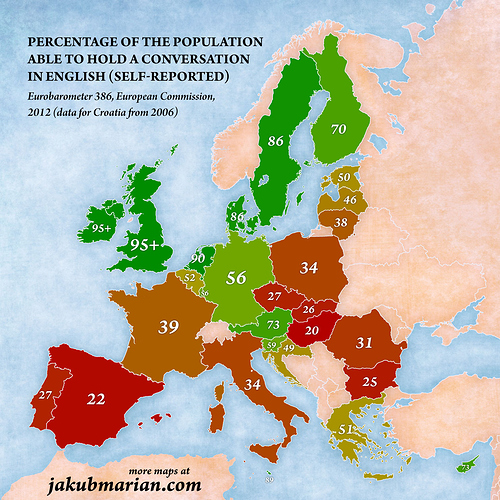I looked at search trends for “PinePhone” (blue), “Librem 5” (red) and “Linux phone” (yellow) in Google, which gave this graph:
As the Librem 5 and then the PinePhone started to be developed, the searches for “Linux phones” have fallen a bit, but if you add the three together, there has been a persistent interest from the public in Linux phones over time.
Searches peaked at times when the phones had something notable. The Librem 5 searches peaked in the weeks when something important happening with the phone:
- Oct 8, 2017: Reached its goal of $1.5 million in preorders to be funded.
- Sep 2, 2018: Announced that shipping would start in Apr. 2019.
- Dec 23, 2019: People checking if the original Q1 2019 shipping would happen.
- Jul 28, 2019: People checking if Q3 2019 shipping would happen.
- Sep 22, 2019: People checking if Aspen was shipping.
- Nov 24, 2019: Birch shipped.
- Jan 12, 2020: Pinephone “Braveheart” shipping
Public interest has fallen a lot in the Librem 5, since the week of Mar 1, 2020. I wonder what caused searches to fall in half after that week and they have stayed low ever since. Maybe it was the coronavirus.
Interest in the Pinephone has been high ever since it announced preorders for Braveheart, but it also had a dropoff in interest after the week of Mar 1, 2020.

Most of the interest in the Librem 5 and PinePhone is focused in Europe. I find it strange that there isn’t more interest in the US, given that Purism is based in San Francisco and PINE64 used to be headquartered in Freemont, California, until it moved to Hong Kong in Dec. 2019.
| Librem 5 | PinePhone | Linux phone | |||
|---|---|---|---|---|---|
| Switzerland | 100 | Switzerland | 100 | Kenya | 100 |
| Finland | 100 | Czechia | 85 | Sri Lanka | 72 |
| Germany | 98 | Finland | 85 | Bangladesh | 51 |
| Austria | 78 | New Zealand | 80 | Pakistan | 44 |
| Czechia | 68 | Germany | 73 | India | 41 |
| Netherlands | 65 | Austria | 64 | South Africa | 41 |
| Sweden | 64 | Netherlands | 62 | Canada | 38 |
| Hungary | 46 | Norway | 59 | Ireland | 36 |
| Canada | 45 | Hungary | 56 | Nigeria | 36 |
| Poland | 42 | Denmark | 53 | Finland | 35 |
| Australia | 40 | Portugal | 53 | Australia | 34 |
| Denmark | 37 | Ireland | 51 | Singapore | 34 |
| France | 37 | Sweden | 50 | Morocco | 33 |
| Belgium | 35 | Canada | 50 | United States | 33 |
| Russia | 32 | Italy | 41 | Philippines | 32 |
| United States | 32 | Poland | 39 | Czechia | 32 |
| Belarus | 28 | France | 38 | Romania | 31 |
| Ukraine | 27 | Belgium | 36 | Greece | 31 |
| Spain | 24 | Russia | 36 | United Kingdom | 29 |
| United Kingdom | 24 | United States | 35 | Israel | 28 |
| Romania | 22 | Australia | 35 | Norway | 28 |
| Italy | 15 | Greece | 32 | Sweden | 28 |
| Taiwan | 13 | Serbia | 32 | Netherlands | 27 |
| Indonesia | 7 | Romania | 32 | Switzerland | 27 |
| India | 6 | Spain | 31 | Portugal | 26 |
| Brazil | 5 | United Kingdom | 28 | Malaysia | 26 |
| Bulgaria | 25 | Belgium | 21 | ||
| Ukraine | 18 | Egypt | 21 | ||
| Philippines | 16 | Austria | 20 | ||
| Taiwan | 12 | Germany | 19 | ||
| Malaysia | 12 | Poland | 16 | ||
| India | 9 | France | 13 | ||
| Indonesia | 9 | Italy | 13 | ||
| Brazil | 7 | Spain | 12 | ||
| Mexico | 6 | Indonesia | 12 | ||
| Japan | 6 | Mexico | 11 | ||
| Turkey | 5 | Ukraine | 11 | ||
| Russia | 10 | ||||
| Brazil | 7 | ||||
| Argentina | 7 | ||||
| Turkey | 6 | ||||
| Vietnam | 6 | ||||
| Japan | 2 |
Based on Google searches, it looks like the PinePhone and Librem 5 phone are mostly selling in the same European, North American and Australian countries, but the PinePhone’s lower price allows it to extend its market to more low-income countries in Asia than the Librem 5.
It doesn’t surprise me that there is so little interest in Asia, Africa and Latin America, because most people in those parts of the world don’t buy their phones online. Japan and South Korea are also closed phone markets where people only buy phones from the domestic brands, so they don’t even think to order a phone from foreign companies like PINE64 and Purism. In my experience, ordering anything online in Latin America is risky and involves a lot of delays getting it through customs.
What is fascinating is the interest in the “Linux phone” in some African and Asian countries. What this suggests is that there might be a market for Linux phones in the developing world, which surprises me. The problem is that it has to be sold offline, and that simply doesn’t work for niche tech-enthusiast phones.
Once Linux phones get established as a recognizable category of phones, I wonder if we are going to see more people using them in places where there is more government surveillance. I can definitely see a market for them among libertarians in the US, but they won’t be the early adopters. Libertarians adopted cryptocurrencies, whereas leftist activists didn’t in the US, so we will probably see the same tendency with the adoption of Linux phones. Sadly, I doubt that Linux phones will sell in China, because the Chinese government won’t look favorably on privacy phones with hardware kill switches. One untapped market is environmentalists. Both the Librem 5 and PinePhone will have a longevity that no Android phone can match in terms of software updates, but environmentalists are not early adopters.



